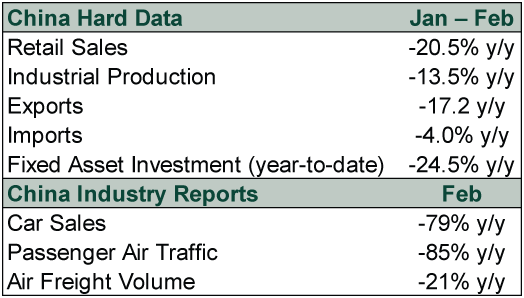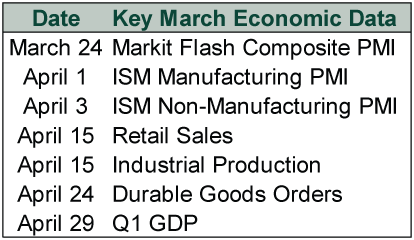Personal Wealth Management / Economics
Assessing Economic Data During COVID-19
What to expect as economic data for March start hitting the wires.
With America closing its borders and many local governments shutting down non-essential business, the fight to slow the COVID-19 pandemic will undeniably have a stark economic impact. How exactly that looks is an open question, though, with much hinging on how long the interruptions to business last. Soon we will start seeing data reflect the impact—and a flood of associated headlines. Here is what we can say now—and how we will be approaching releases as they come.
China provides a preview. The coronavirus’s spread escalated exponentially during mid-January’s Lunar New Year holiday. The ensuing public health emergency and containment—quarantines, city-wide lockdowns and travel restrictions—severely curtailed economic activity through February and early March. Data are now starting to reflect the damage. February’s manufacturing purchasing managers’ index (PMI) fell to a record low 35.7 from January’s 50.0—the dividing line between expansion and contraction.[i] February’s non-manufacturing PMI suffered a steeper decline from January’s 54.1 to 29.6—also a record low.[ii] China combines most of the rest of its official data for January and February to even out skew from the Lunar New Year’s shifting timing. As shown in Exhibit 1, they were awful across the board.
Exhibit 1: Chinese Economic Data Has Tanked
Source: National Bureau of Statistics of China, FactSet and CNN, as of 3/20/2020.
Economists presume China’s Q1 GDP will contract, as the country is only just starting to return to work. But returning it is. Slowly but surely, firms are restoring production. Excluding Hubei province, where the virus originated, 95% of large firms and 60% of small- and medium-sized firms have returned to work, according to China’s Ministry of Industry and Information Technology. Within Wuhan, analysts and observers expect most businesses to be back online by month’s end. This is as daily new Chinese coronavirus cases—and deaths—shrank dramatically in mid-March, with the country reporting zero new locally transmitted cases on March 19 versus thousands a month ago. (There were some new cases reported from Chinese travelers returning home.) Time will tell whether the Western world’s experience is comparable, but the relatively fast turnaround—especially amid the dead of winter—is encouraging.
It seems reasonable to expect America—and other affected areas—to have similarly severe numbers. Initial data covering March—when business interruptions began in earnest—point to a steep drop in activity. Jobless claims jumped 70,000 to 281,000 for the week ending March 14, its highest level in two years.[iii] Most expect that to rise by a record amount—perhaps more than a couple million—when the numbers for last week come out on Thursday. Regional PMIs, which we don’t normally emphasize due to their geographic narrowness, also hint at a shock. The New York Fed’s Manufacturing PMI fell -34.4 points—the most on record—to -21.5 in March.[iv] (Here, below zero indicates contraction.) The Philadelphia Fed’s Manufacturing PMI fell from February’s 36.7 to -12.7, its lowest level in eight years.[v] Don’t be shocked if national PMIs plunge similarly.
As for harder data, COVID-19 containment probably impacts most metrics. Event cancellations and plunging travel have downstream impact on local retail sales, food service and entertainment. Yet this may be somewhat offset by the big surges in sales at grocers and online retailers—as panic pulled forward some demand. Many stores have now closed nationwide for the rest of the month, which will further hit retail sales. Manufacturing is starting to feel the pain, as automakers and others have announced temporary factory shutdowns. We wouldn’t be surprised by a steady stream of industry- and company-specific warnings either as a result of shutdowns and order cancellations. Anticipating this now is good preparation so you won’t be shocked later. Whether data in April and beyond will be as bad is unknowable now, as it depends on how long containment policies persist.
Exhibit 2: Upcoming Economic Releases
Source: FactSet, as of 3/17/2020.
Many will also watch the Atlanta and New York Fed’s GDP “nowcasts”—evolving estimates for Q1 GDP based on available data. Expect them to fluctuate as new data come in. Currently, the Atlanta Fed’s GDPNow indicates 3.1% annualized growth in Q1.[vi] This seems lofty, but it primarily includes January and February data. Using a different model, the New York Fed’s Q1 Nowcast stands at 1.5% annualized.[vii] Meanwhile, economists expect 1.3% annualized growth in Q1, but they are penciling in a -0.1% Q2 dip.[viii] Some estimates are far, far worse.
In our view, the most important—and potentially most difficult—task for investors will be to not let these backward-looking data influence forward-looking decisions. Dismal numbers are difficult to swallow, but stocks generally move before economic trends shift. Stocks had to price in a mounting likelihood of recession in a hurry. They did so in mere days, entering a bear market well before any data confirmed an economic downturn. Experience teaches us that they likely do the same on the other side. The last bear market ended in March 2009, while the recession lasted through June. Data didn’t start confirming green shoots until later in the summer, unemployment continued rising through early 2010, and NBER didn’t officially declare the recession over until later that year.
Chinese stocks tell a similar story. Since its markets reopened February 3, the MSCI China A Index has outperformed the MSCI All-Country World Index (which includes developed and Emerging Markets) by over 20 percentage points.[ix] The index even rose for the first seven days, nearly recapturing the prior high, before the prospect of recession in the developed world created fear of weakening demand for Chinese goods.
The economic effects of the business disruptions will likely be severe. How long they last is important. But, for investors, we think it is critical to recall that markets are likely to move ahead of these data. Markets typically anticipate the rays of sunshine stemming from improved activity well before society or pundits can see the light.
[i] Source: National Bureau of Statistics of China, as of 2/28/2020. China manufacturing PMI, January 2020 – February 2020.
[ii] Ibid. China non-manufacturing PMI, January 2020 – February 2020.
[iii] Source: Federal Reserve Bank of St. Louis, as of 3/19/2020. Weekly initial claims for unemployment insurance, 10/2/1982 and 3/28/2009.
[iv] Source: Federal Reserve Bank of New York, 3/17/2020. Empire State Manufacturing Survey, March 2020.
[v] Source: Federal Reserve Bank of Philadelphia, 3/19/2020. Manufacturing Business Outlook Survey, March 2020.
[vi] Source: Federal Reserve Bank of Atlanta, as of 3/20/2020. GDPNow, 3/18/2020.
[vii] Source: Federal Reserve Bank of New York, as of 3/20/2020. Nowcast, 3/20/2020.
[viii] Source: The Wall Street Journal, as of 3/20/2020. Economic Forecasting Survey for GDP, Q1 2020 and Q2 2020.
[ix] Source: FactSet, as of 3/18/2020. MSCI China A Index minus MSCI ACWI Index returns with net dividends, 12/31/2019 – 3/17/2020.
If you would like to contact the editors responsible for this article, please message MarketMinder directly.
*The content contained in this article represents only the opinions and viewpoints of the Fisher Investments editorial staff.
Get a weekly roundup of our market insights
Sign up for our weekly e-mail newsletter.

You Imagine Your Future. We Help You Get There.
Are you ready to start your journey to a better financial future?

Where Might the Market Go Next?
Confidently tackle the market’s ups and downs with independent research and analysis that tells you where we think stocks are headed—and why.







